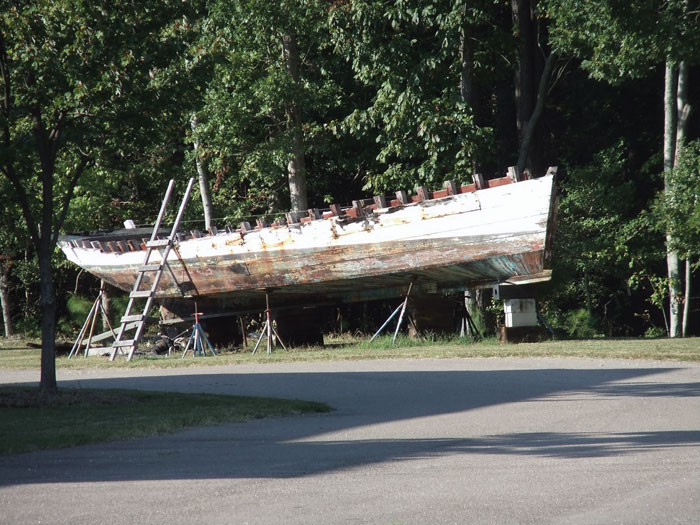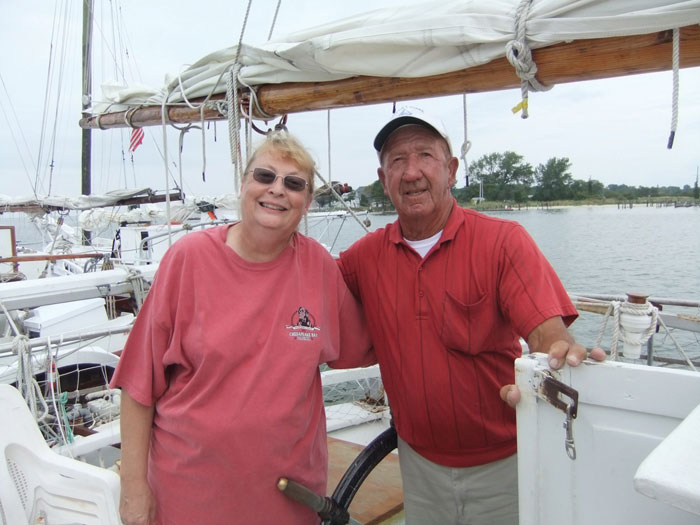Coming Back From the Brink of Extinction
The historic Chesapeake Bay skipjacks, the nation’s only remaining commercial sailing fleet, are coming back from the brink of extinction thanks to the efforts of some dedicated individuals.
When the Tilghman Island skipjack Rebecca T. Ruark sank in a 1999 storm, the plight of this oldest skipjack in the fleet drew enough attention to the critical condition of the boats that the state of Maryland formed the Save Our Skipjacks Task Force to find ways to keep the remaining skipjacks alive. The task force resulted in funding for a Skipjack Restoration Project at the Chesapeake Bay Maritime Museum. The program provided repairs or restoration for at least nine boats before running out of money.
To the Rescue
The assistance made a difference for a while, but where there once were 600 to 800 or more skipjacks working the Bay waters, only five skipjacks dredged during the 2008-2009 season. Of the rest of the couple dozen original dredge boats still alive, some had been retasked into tourist vessels, but many were in danger of being abandoned and lost as the Bay’s oyster harvests dwindled. Then, people who simply love skipjacks began coming to the rescue. One of them was Kitty Sims Ledsome.
“I never really knew why I loved Somerset County and the water so much,” she said. “Maybe it was the way my father and grandfather showed me the way watermen work to make a living.”
Now living in Norfolk, she said she would visit her grandparents, who lived outside of Princess Anne, when she was growing up and ride out to Deal Island to get soft shell crabs. There, she saw all the skipjacks at the dock. “Back then there were so many.”
In 2012, Ledsome and her boyfriend, John Moscoe, went to the Deal Island Skipjack Race and were invited onboard the skipjack Rebecca T. Ruark by her captain, Wade Murphy, Jr.
The George W. Collier
When he heard Kitty was from Norfolk, Murphy told her the story of quitting school at age 16 to begin working on his father’s skipjack, George W. Collier, which was built in 1900 at Deal Island. He had heard the Collier was now somewhere in Cape Charles, VA, and Kitty promised she would find the boat for him.
“What we would later find out was heartbreaking,” she said.
Kitty and John traced the Collier’s history through newspaper articles and the internet. They read about the Allegheny Beverage Corporation once owning the boat, renamed Allegheny, and sailing her to promote the company. They read about the City of Norfolk later acquiring her, renaming her Norfolk, and using her to train Sea Scouts and as an ambassador for the city. Next, the boat went to a nonprofit organization that was going to restore her in Cape Charles after her condition became critically deteriorated.
Determined to find the Collier, Kitty and John went to Cape Charles and tracked down someone who knew where she was. They were told to go down the road, past the concrete plant to the chemical warehouse.
“I could not believe my eyes,” said Kitty. “I kept telling John that can’t be her.” She had been cut down to the waterline, with no restoration apparent. “Our hearts were broken,” she said, but Kitty had an idea.
They took pictures and called the Virginian-Pilot, telling the paper about the Collier’s plight. A reporter wrote a story which ran in October 2012, and she sent a clipping along with photos of the boat to Captain Wade, promising that she would keep trying to save her.
They started sending letters to everyone they could find who had anything to do with restoring skipjacks and other work boats. No one answered their pleas. Kitty wrote a poem for the boat that she planned to pin to the Collier’s side, hoping someone would read it and save her:
Take me to the water’s edge
Lay my keel in the soft sand
Let the water touch my hull again
Let me die like my sisters have
Let the tides and time take me away.
To die on land and never feel ebb’s tide
Is no way for a Skipjack to die.
As they waited for help to appear, they also researched Kitty’s genealogy and found the heritage from which her love of the water grew. They discovered roots in Holland Island, a three-times-great uncle who built skipjacks, a great-grandfather who was a captain—“of what I haven’t found out yet”—and a great uncle who was a waterman. But still there was no luck in finding help for the Collier. “I got so depressed, but never gave up hope.”
Momentum Developed
Meanwhile, in 2011, captain Stoney Whitelock had begun a major restoration of his skipjack Kathryn at Deal Island. Built in 1901 and designated a National Historic Landmark, Kathryn was relaunched this summer. Mike Vlahovich of Coastal Heritage Alliance oversaw the restoration.
The momentum developed by the work on Kathryn led Whitelock and three others to buy Helen Virginia in 2013 and take her down to Deal Island for a year-long restoration. An organization, Deal Island Skipjack Preservation, was set up to support the work. One of Helen Virginia’s owners, Katarina Ennerfelt, won the 2014 Deal Island Skipjack Race on Labor Day with her all-female crew only days after Helen Virginia was relaunched.
With Helen Virginia sailing again and work on Kathryn wrapping up, Whitelock was looking ahead to see what other skipjacks could be saved when he learned of George W. Collier rotting away down at Cape Charles. Jerry and Julie Moser, who had been working with Deal Island Skipjack Preservation in support of the restoration efforts, contacted the nonprofit that owned the Collier and found it was willing to part with her if someone could get her restored.
Whitelock and Jerry Moser went down to Cape Charles to take a look at the boat. “She was not much different from any of the rest of them,” said Whitelock, referring to the general condition of many of the skipjacks in need of restoration. They braced her up with two by fours and arranged for a hydraulic trailer to haul the Collier up to Deal Island.
When John found the George W. Collier Skipjack Restoration Facebook page that was set up in June, Kitty said she could not believe her eyes. They immediately contacted the Mosers and found that the Collier would be going home to Deal Island on July 3.
“We went to Cape Charles that day to help pack up the old girl,” said Kitty, meeting the Mosers and others from Deal Island. The Virginian-Pilot covered the story. “This was history we were saving,” she said.
After the boat left Cape Charles, Kitty stood there, looking at the empty spot, and cried.
Sitting At the Water's Edge
Three years of caring, fighting to save her, were now over. The boat was in someone else’s hands. George W. Collier now sits by the water’s edge at Deal Island, waiting once again for her turn to be restored. Kitty and John have visited her a couple of times. Kitty says her dream now is that “one day captain Wade and I will stand on the deck of the G.W. Collier when she is restored and in the water.”
According to Whitelock, that may take another three or four years and about $200,000. But Kitty said she got a “very heart-felt ‘thank you’” from Captain Wade when he arrived at Deal Island for this year’s skipjack race, where Kitty was waiting for him.
“That made my day,” she said. “I guess with everything, I helped save Captain Wade Murphy’s heritage, and I found mine.”
After patiently waiting for a year at the water’s edge, she was transferred to the Skipjack Museum and Heritage Center in Chance to begin restoration. All the required white oak and pine are on site, and restoration work is expected to begin soon by renowned skipjack captain and restorer Whitelock.
by Catherine Sims Ledsome and Cindy Carrington Miller
For more information, visit the Facebook pages for Skipjack George W. Collier and Last Skipjacks Project.






